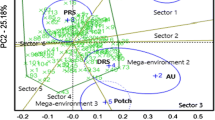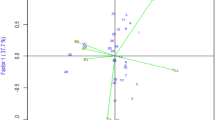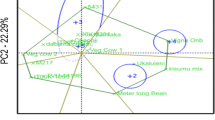Summary
The identification of environments suitable for selection should enable plant breeders to test reliably a larger number of genotypes with given resources. This research was undertaken to evaluate discrimination ability (DA) and prediction ability (PA) of eight environments involving two locations. Eckartsweier (Eck) 1 and Voelkenrode (Voe); 2 yer. 1984 (84) and 1985 (85); and two harvests, silage harvest (I) and later (II). It was based on dry matter yield of plant (PDMY), ear (EDMY) and stover (SDMY) and on in vitro digestible organic matter (IVDOM), neutral detergent fibre (NDF), acid detergent fibre (ADF) and acid detergent lignin (ADL) of stover of 12 inbred lines and their 66 diallel crosses in maize (Zea mays L.). Linear regression coefficient of the performance of genotypes in an environment on that averaged across all environments and its degree of determination were used as measures of the DA and PA of environments, respectively. In hybrids, the DA of environments differed significantly for all traits except SDMY and ADL. Environment Eck851 showed better PA (≥0.63) than other environments for PDMY, EDMY, IVDOM, NDF, and ADF. Among the 12 two-environment combinations. EckI was a better predictor for PDMY, EDMY, IVDOM and NDF (PA≥0.80). The more productive environments showed better DA and PA for PDMY and FDMY than less productive ones. For IVDOM and NDF the first harvest provided better discrimination and prediction than the second harvest. In inbred lines the DA of environments differed significantly for EDMY only. In the present study, PA and DA seemed to be functions of the environments, PA was improved by combining two environments, and some environments seemed to be suitable for preliminary selection of genotypes for such diverse traits as yield and digestibility.
Similar content being viewed by others
References
Abbou-El-Fittouh, H.A., J.O., Rawlings & P.A., Miller, 1969. Classification of environments to control genotype x environment interactions with an application to cotton. Crop Sci. 9: 135–140.
Allen, F.L., R.E., Comstock & D.C., Rasmusson, 1978. Optimal environments for yield testing. Crop Sci. 18: 747–751.
Brown, K.D., M.E., Sorrells & W.R., Coffman, 1983. A method for classification and evaluation of testing environments. Crop Sci. 23: 889–893.
Fakorede, M.A.B., 1986. Selection of sites for preliminary maize yield trials in the rainforest zone of South-Western Nigeria. Euphytica 35: 441–447.
Goering, H.K. & P.J.van, Soest, 1970. Forage Fiber Analysis (apparatus, reagents, procedures, and some applications). USDA-ARS Agric. Handb. 379. U.S. Gov. Print. Office, Washington DC.
Hamblin, J., H.M., Fisher & H.L., Ridings, 1980. The choice of locality for plant breeding when selecting for high yield and general adaptation. Euphytica 29: 161–168.
Horner, T.W. & K.J., Frey, 1957. Methods of determining natural areas for oat varietal recommendations. Agron. J. 49: 313–315.
Johnson, G.R. & K.J., Frey, 1967. Heritabilities of quantitative attributes of oats (Avena sp.) at varying levels of environmental stress. Crop Sci. 7: 43–46.
Misevic, D. & J., Dumanovic, 1989. Examination of methods for choosing locations for preliminary maize yield testing. Euphytica 44: 173–180.
Pollak, L.M. & H.N., Pham, 1989. Classification of maize testing locations in Sub-Saharan Africa by using agroclimatic data. Maydica 34: 43–51.
Pollmer, W.G., D., Eberhard, D., Klein & B.S., Dhillon, 1980. Stability of performance of high-yielding maize (Zea mays L.) hybrids. In: W.G., Pollmer & R.H., Phipps (Eds)., Improvement of Quality Traits of Maize for Grain and Silage Use. p. 257–272. Martinus Nijhoff Publishers B.V., The Hague.
Tilley, J.M.A. & R.A., Terry, 1963. A two-stage technique for the in vitro digestion of forage crops. J. Brit. Grassl. Soc. 18: 104–111.
Utz, H.F., 1972. Die Zerlegung der Genotyp x Umwelt-Interaktionen. EDV in Medizin und Biologie 3: 52–59.
Vela-Cardenas, M. & K.J., Frey, 1972. Optimum environment for maximizing heritability and genetic gain from selection. Iowa State J. Sci 46: 381–394.
Weber, W.E. & M., Vanselow, 1985. Die Eignung von Prüforten zur Selektion von Sorten auf Ertrag, ermittelt aus amtlichen Prüfungen bei Winterweizen und Mais. Pflanzenzuechtg. 94: 64–73.
Author information
Authors and Affiliations
Rights and permissions
About this article
Cite this article
Dhillon, B.S., Utz, H.F., Pollmer, W.G. et al. Evaluation of environments for preliminary testing of maize for yield and stover digestibility. Euphytica 54, 19–26 (1991). https://doi.org/10.1007/BF00145626
Received:
Accepted:
Issue Date:
DOI: https://doi.org/10.1007/BF00145626




